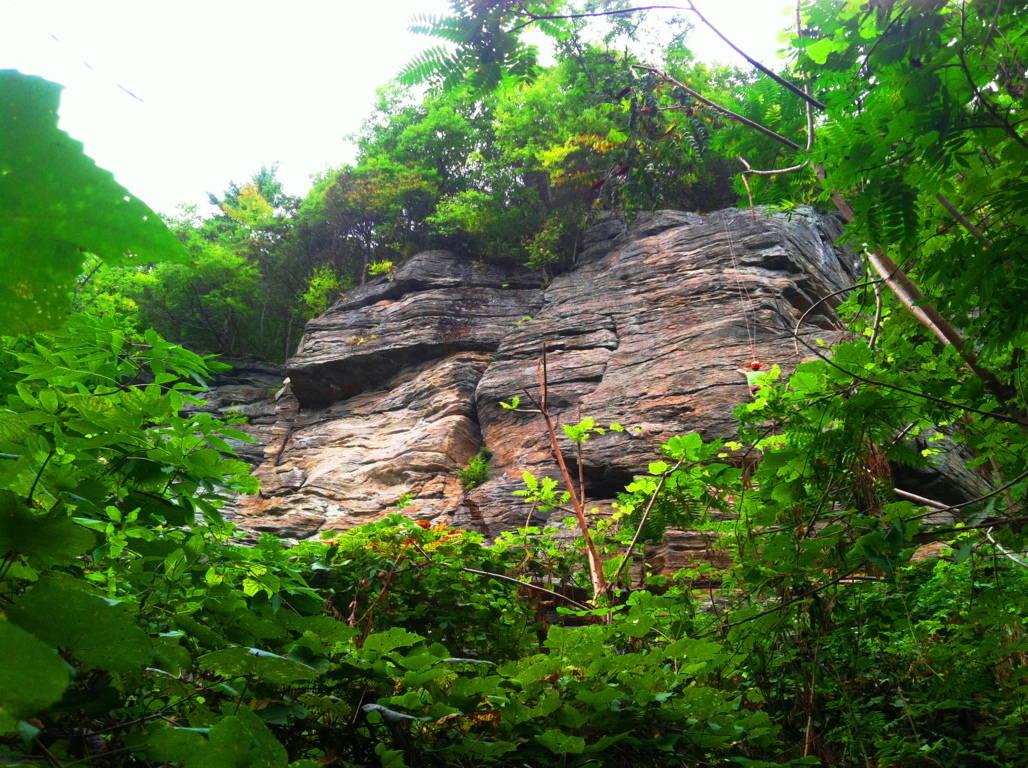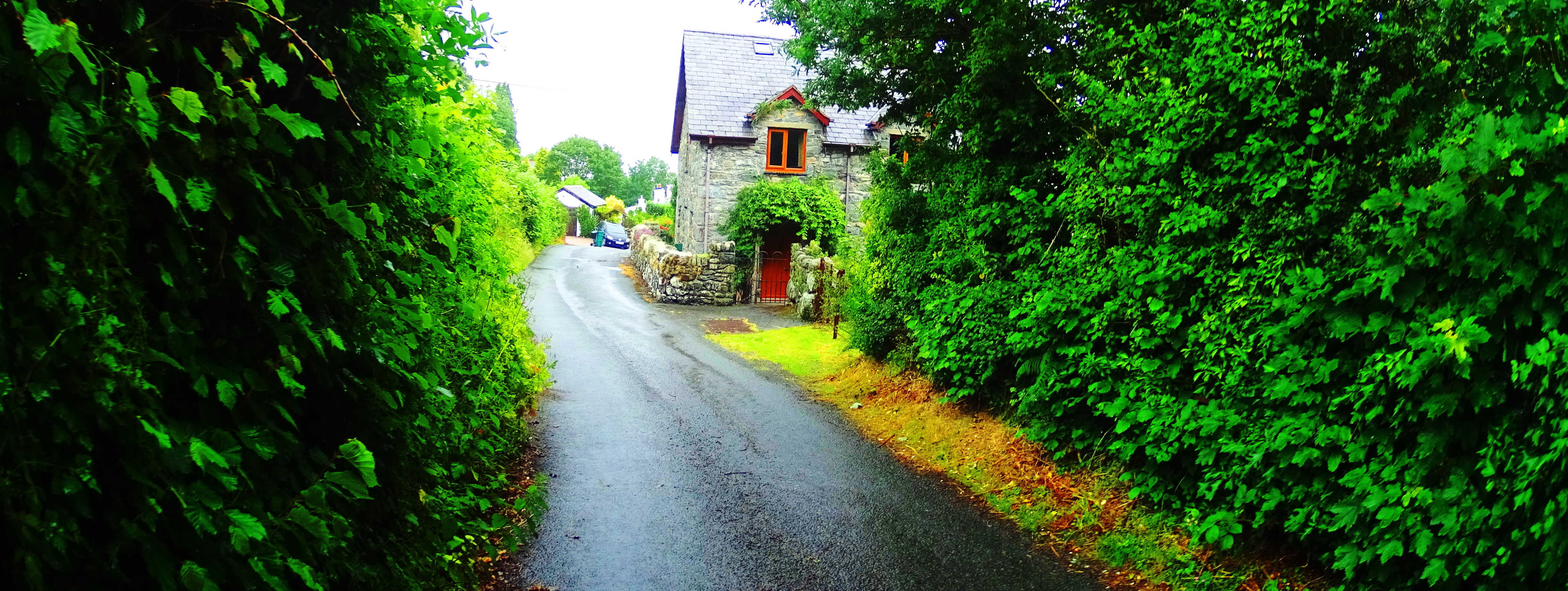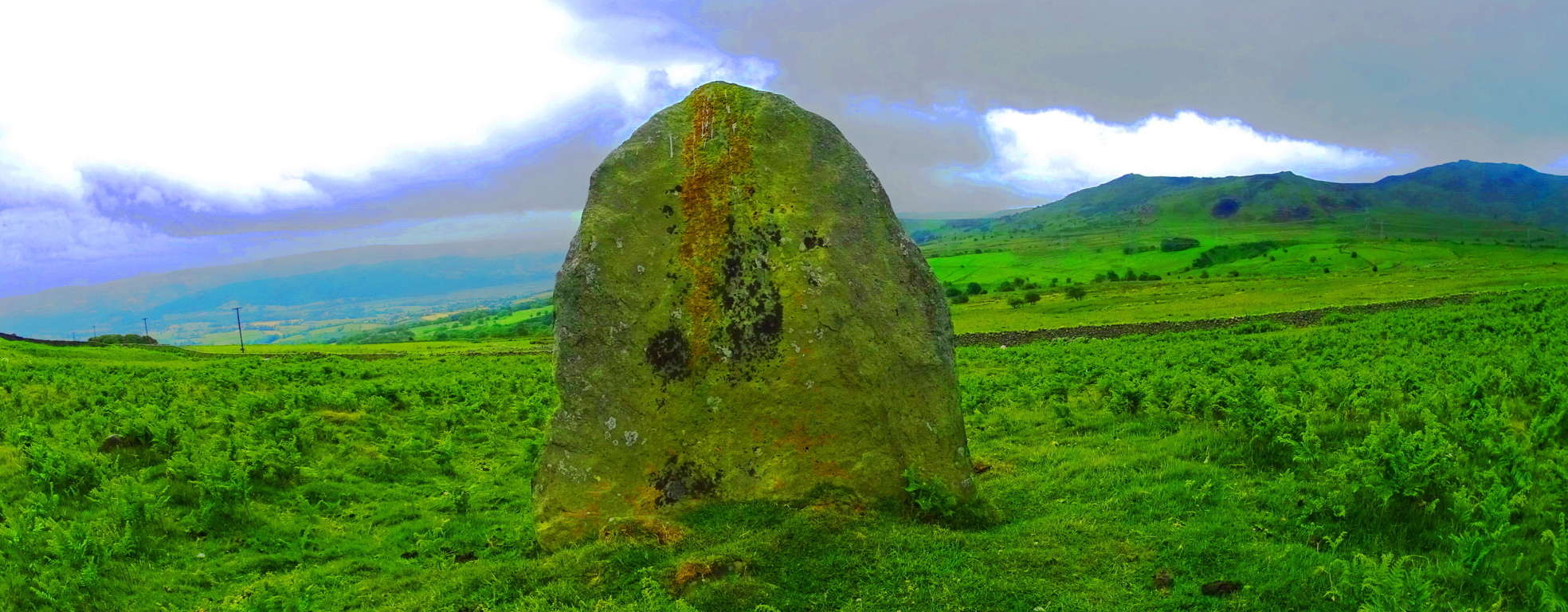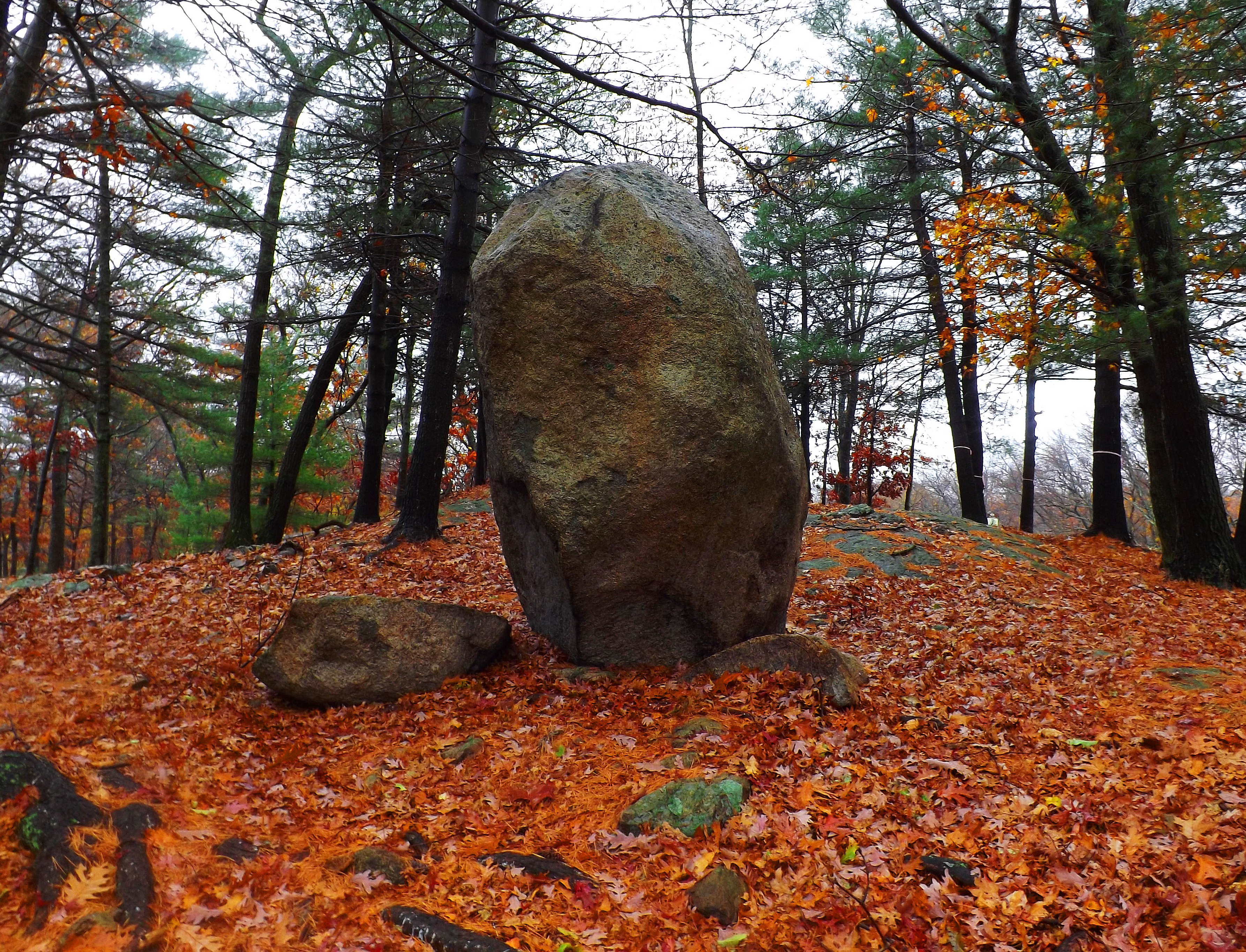Rattlesnake Mountain

Location: Erving, Massachusetts
Elevation: 1,067 ft
Note: Running along the northern border of Massachusetts is a unique set of rolling “small-mountain” ranges. These elevations are too tall to be called mere hills, but too small to be known as full-fledged mountains. Rattlesnake Mountain sits in the heart of this range in the northwestern portion of the state, surrounded by similar small-mountain peaks in Monroe and Savoy to the west, with Watatic to the east. The woodsy entrance for the car park leading to the main trail at Rattlesnake Mountain is nearly hidden, just off Rt 2A, about 100 yards from Maple Ave, in the picturesque country-town of Erving.
The trail at Rattlesnake’ is essentially a 2.4 mile loop that broadly encircles a massive metamorphic rock ledge. Known as The Farley Ledges, this precipice is enveloped by trees, standing about 220 feet high, and about a mile-and-a-half wide, east to west (image below)… Rock climbers scale this ledge in a world all their own, paying very little attention to the boulders and stones that line the ground below. If they did pay attention, a closer look at these stones reveal something pretty amazing. Here at Rattlesnake’ there is a megalithic mystery that reaches deep into the heart of Massachusetts forests and mountains, a mystery that most often goes unspoken. Simply put, there are hundreds of gigantic cut stones which are measured and marked inundating the forest floor just beneath the ridge. There are pathways that run directly into this “stone playground” where various crafted stones sit (image below)…
Rock climbers scale this ledge in a world all their own, paying very little attention to the boulders and stones that line the ground below. If they did pay attention, a closer look at these stones reveal something pretty amazing. Here at Rattlesnake’ there is a megalithic mystery that reaches deep into the heart of Massachusetts forests and mountains, a mystery that most often goes unspoken. Simply put, there are hundreds of gigantic cut stones which are measured and marked inundating the forest floor just beneath the ridge. There are pathways that run directly into this “stone playground” where various crafted stones sit (image below)… Other megaliths are fixed in some pretty curious positions in arrangements near the trail, winding like a display along the ledge (image below)…
Other megaliths are fixed in some pretty curious positions in arrangements near the trail, winding like a display along the ledge (image below)… Some of the stones look to be placed in specific places, while others look to have been tossed about like giant toy blocks. The incrementation markings on the huge stones are not in inches or centimeters, they are some other form of measurement entirely. The image above is of two rather long rectangular pieces thrown into a pile at Rattlesnake’. Pieces exactly like this exist at the pass of Mount Bearnagh in Ireland (image below)…
Some of the stones look to be placed in specific places, while others look to have been tossed about like giant toy blocks. The incrementation markings on the huge stones are not in inches or centimeters, they are some other form of measurement entirely. The image above is of two rather long rectangular pieces thrown into a pile at Rattlesnake’. Pieces exactly like this exist at the pass of Mount Bearnagh in Ireland (image below)… They also exist at Lynn Woods Reserve in Lynn Massachusetts (image below)…
They also exist at Lynn Woods Reserve in Lynn Massachusetts (image below)… which is 40 miles east of here. Look at the incrementation on the stone in Lynn Woods; between the long marks are 9 short marks. What system of measurement uses increments of 9? And there are countless other places throughout New England where this specific type of rectangular piece can be found. As documented proof of these megalithic stones is slowly compiled, it becomes clear that our modern culture is built directly over what was once a megalithic culture. In old-growth forests and mountain ridges where houses have never been built the evidence for this culture still remains. And please remember, these stones are several tons each, if not more. Whoever cut and placed them, had the ability to do so, and without strain. Other stones beneath the ridge are smaller square pieces (image below)…
which is 40 miles east of here. Look at the incrementation on the stone in Lynn Woods; between the long marks are 9 short marks. What system of measurement uses increments of 9? And there are countless other places throughout New England where this specific type of rectangular piece can be found. As documented proof of these megalithic stones is slowly compiled, it becomes clear that our modern culture is built directly over what was once a megalithic culture. In old-growth forests and mountain ridges where houses have never been built the evidence for this culture still remains. And please remember, these stones are several tons each, if not more. Whoever cut and placed them, had the ability to do so, and without strain. Other stones beneath the ridge are smaller square pieces (image below)…
And more stones can be found here, some covered by countless seasons, or are partially entrenched in the earth. It becomes clear that someone literally went to work in this area, and was utilizing megalithic size stones the way a carpenter uses wood blocks (images below)…


As you head east along the initial trail, passing by these monoliths and huge fixtures, there are other stones that emerge which are relevant to the patterns of megaliths in New England. The equilateral triangle has showed its face in stone in almost every deep woods hiking trail and reserve from northern Maine to western Massachusetts. Here, somehow fixed into a boulder, was a perfect equilateral triangle (image below)… It is at the center of this massive fixture, with a cubicly cut stone to its left, and another perfect equilateral to its right. All of this is under a rock precipice serving as a roof which looks to weigh about 100 tons. The overall symmetrical setting is above (image above), with the central equilateral in the middle, sitting on a perfectly leveled shelf of stone. Please understand, this stone is part of the boulder beneath it; it was carved out to protrude specifically in this fashion. I could not move it. Here’s a closer look (image below)
It is at the center of this massive fixture, with a cubicly cut stone to its left, and another perfect equilateral to its right. All of this is under a rock precipice serving as a roof which looks to weigh about 100 tons. The overall symmetrical setting is above (image above), with the central equilateral in the middle, sitting on a perfectly leveled shelf of stone. Please understand, this stone is part of the boulder beneath it; it was carved out to protrude specifically in this fashion. I could not move it. Here’s a closer look (image below) Just a few feet up the trail is another fixture with a equilateral triangle that is guarded by several massive stones. This stone is not only an equilateral, but is a three sided prism that is connected to the boulder beneath it. (image below)
Just a few feet up the trail is another fixture with a equilateral triangle that is guarded by several massive stones. This stone is not only an equilateral, but is a three sided prism that is connected to the boulder beneath it. (image below) In the woods of Upton Massachusetts there are granite cut equilateral prisms attached to the boulders beneath them (image below), extremely similar to these stones found at Rattlesnake’.
In the woods of Upton Massachusetts there are granite cut equilateral prisms attached to the boulders beneath them (image below), extremely similar to these stones found at Rattlesnake’. I believe the Triangle is the megalithic “calling card” of the ancient culture that once dwelt in the hills of New England, just as the Spiral was the calling card of the megalithic culture that once dwelt once dwelt in Ireland. If you recognize this, then you will realize that New England, in its own way, is a landscape that is just as mythical and beautiful as those traditionally endeared in England, Ireland, Scotland, and Wales. When you hike through these small mountains, you’re hiking through zones of ancient mysteries yet to be solved, but can be seen right before your eyes. The trees of woods are spaced amicably, with small groves of baby pines and birches emerging in various areas. Enjoy these beautiful groves (image below )…
I believe the Triangle is the megalithic “calling card” of the ancient culture that once dwelt in the hills of New England, just as the Spiral was the calling card of the megalithic culture that once dwelt once dwelt in Ireland. If you recognize this, then you will realize that New England, in its own way, is a landscape that is just as mythical and beautiful as those traditionally endeared in England, Ireland, Scotland, and Wales. When you hike through these small mountains, you’re hiking through zones of ancient mysteries yet to be solved, but can be seen right before your eyes. The trees of woods are spaced amicably, with small groves of baby pines and birches emerging in various areas. Enjoy these beautiful groves (image below )…  With all of this existing right infornt of you, it can be hard to get back to the natural beauty of the trail ahead, which is another wonderful aspect to hiking the forests of New England and Rattlesnake Mountain. As you step away from these mysterious alters beneath the grand ledge, continue east. After about 1/4 mile you will come to a stream rolling down the mountain from above (image below).
With all of this existing right infornt of you, it can be hard to get back to the natural beauty of the trail ahead, which is another wonderful aspect to hiking the forests of New England and Rattlesnake Mountain. As you step away from these mysterious alters beneath the grand ledge, continue east. After about 1/4 mile you will come to a stream rolling down the mountain from above (image below). Turn to follow this stream upward, as you are now on the eastern extremity of the trail (image below).
Turn to follow this stream upward, as you are now on the eastern extremity of the trail (image below).
This waterway is so similar to Celtic scenes that you might find at Tollymore Forest in Ireland, or Killarney National Park. The rocks are strewn over the flowing water, with glowing moss beyond. Following the waterways clears the senses and improves your “sound palate” with the soft trickling and smooth rolling of water over stone. This consistency of sound eliminates the sensory overload we experience in our daily lives, which have become controlled blasts of commercial intrusions. One walk along these streams can clear your head for days. Continue up the incline which follows the stream until the trail crosses over the water, to left, at the top of the hillside. The trail continues into an elevated old-growth forest with a classic New England blend of Oak, Maple, Pine, Beech, and Birch trees. Looking northward this forest continues all the way into Vermont.(image below) Continuing west on the elevated trail there are minature ledges with tiny pillars creating a tiny cavern on the underside of the precipice (image below)…
Continuing west on the elevated trail there are minature ledges with tiny pillars creating a tiny cavern on the underside of the precipice (image below)… At Cavan Burren National Park in Ireland, where there are some of the most astounding Celtic megalithic monuments in the world, there are also notable stone ledges with the small pillars creating a cavern beneath the tiny granite ridge (image below)…
At Cavan Burren National Park in Ireland, where there are some of the most astounding Celtic megalithic monuments in the world, there are also notable stone ledges with the small pillars creating a cavern beneath the tiny granite ridge (image below)… After passing these curious small pillars the trail continues west for about a mile, where other large flat cliffs emerge to the north. These gigantic shelves are layered in loose parallel shafts for 50 to 100 yards each, at about 45 feet in height. (image below)
After passing these curious small pillars the trail continues west for about a mile, where other large flat cliffs emerge to the north. These gigantic shelves are layered in loose parallel shafts for 50 to 100 yards each, at about 45 feet in height. (image below)
In some places there are small standing stones at the edges of these small cliffs (below)…
A similar stone in the historically megalithic town of Upton stands, just like this stone in Rattlesnake’, along a large stone-lining near the ancient Upton Chamber (below)…
Keep in mind that these are not “small” stones, they are cut and crafted granite pieces that go as far into the ground as they are above; and they are perfectly squared. They are clearly a cultural marker of some kind created in antiquity. You will continue to follow the trail west until it turns left again, towards the western edge of the Farley Ledges, where the best lookout of the trail is found after about another 1/4 mile.  The woods on this western edge of the trail are massive shelves and boulders overgrown with classic New England Fauna (image below)…
The woods on this western edge of the trail are massive shelves and boulders overgrown with classic New England Fauna (image below)… At the western extreme of the trail, over looking Route 2A, is the southerly view of the heart of Massachusetts (image below)…
At the western extreme of the trail, over looking Route 2A, is the southerly view of the heart of Massachusetts (image below)… 
After taking in this view, the last portion of the loop descends back along Farley Ledge to the east. There are miniature canyons below, and gigantic granite walls slicing through the hills (image below)… You will eventually come to a lower crossing of the stream at the eastern edge of the trail, then head back down to the megaliths below at Farley Ledge.
You will eventually come to a lower crossing of the stream at the eastern edge of the trail, then head back down to the megaliths below at Farley Ledge.
Rattlesnake Mountain is yet another example of classic New England hiking that combines practically magical megalithic statements in the forest and mountains with a pristine hiking experience. Time after time, forests and mountains of Celtic and New England places reveal a related megalithic mystery yet to be acknowledged by so many academics. Rattlesnake is clearly one of these sacred places, and it will grant the hiker a vision of something miraculous, something which is calling out to us from a culture that left its mark in a way that will never fade. You can touch these signature stones yourself, see the size and scope of them, walk the trails, and simply wander right into the hallowed wonder of it all.






 After stopping to appreciate this magnificent stone, continue in the same direction further along the Roman road, and look left again. The Dolmen sits about 50 yards away and can be seen from the road facing the valley below. It is a sight to behold. This is a classic “Portal Tomb” of the same era as the legendary Poulnabrone Dolmen in The Burren Ireland , across the Celtic Sea. Although it may look somewhat small against the broad valley, a closer look reveals a capstone weighing at least 5 tons.
After stopping to appreciate this magnificent stone, continue in the same direction further along the Roman road, and look left again. The Dolmen sits about 50 yards away and can be seen from the road facing the valley below. It is a sight to behold. This is a classic “Portal Tomb” of the same era as the legendary Poulnabrone Dolmen in The Burren Ireland , across the Celtic Sea. Although it may look somewhat small against the broad valley, a closer look reveals a capstone weighing at least 5 tons. This capstone is directly aligned to a beautiful peak roughly ten miles away across the valley. This is a trait that most Dolmens display: the facing of the most beautiful vantage in the area.
This capstone is directly aligned to a beautiful peak roughly ten miles away across the valley. This is a trait that most Dolmens display: the facing of the most beautiful vantage in the area.


